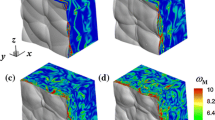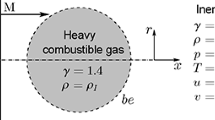Abstract
Detonation propagating in a T-shaped tube with quiescent and moving hydrogen/oxygen/argon mixtures is numerically examined based on the Euler equations with detailed finite-rate chemistry using the fifth-order weighted essentially non-oscillatory scheme. When diffracted in a quiescent combustible mixture, the detonation wave propagating from the bottom of the T-shaped tube is influenced by the corner rarefaction waves and decays into a non-reacting shock. Subsequently, the decoupled shock reflects irregularly from the top wall. Through several reflections back and forth between the top and bottom walls, a planar detonation is finally re-established. When the combustible mixture in the horizontal part flows from the left to the right, the detonation products ejected from the vertical tube will retard the flow, generating a compression flow upstream and a rarefaction flow downstream. The disturbed detonation on the left side is stronger than that on the right side. The final planar detonation in the upstream direction propagates faster than the Chapman–Jouguet (CJ) detonation with compressed, fine cellular structures, whereas the detonation in the downstream direction propagates more slowly than the CJ detonation with elongated, coarse cellular structures. The details of the transient behavior of diffracting detonation in high-speed flows are discussed.




















Similar content being viewed by others

References
Kailasanath, K.: Review of propulsion application of detonation waves. AIAA J. 38(9), 1698–1708 (2000)
McKenna, W.W.: Interaction between detonation waves and flowfields. AIAA J. 5(5), 868–873 (1967)
Vasil’ev, A.A., Zvegintsev, V.I., Nalivaichenko, D.G.: Detonation waves in reactive supersonic flow. Combust. Explos. Shock Waves 42, 568–581 (2006)
Yi, T.H., Wilson, D.R., Lu, F.K.: Numerical study of unsteady detonation wave propagation in a supersonic combustion chamber. In: Proceedings of the 25th International Symposium on Shock Waves, paper no. 10041 (2004)
Ishii, K., Kataoka, H., Kojima, T.: Initiation and propagation of detonation waves in combustible high speed flows. Proc. Combust. Inst. 32, 2323–2330 (2009)
Zeldovich, IaB, Kogarko, S.M., Simonov, N.N.: An experimental investigation of spherical detonation in gases. Sov. Phys. Tech. Phys. 1(8), 1689–1713 (1956)
Soloukhin, R.I., Ragland, K.W.: Ignition processes in expanding detonations. Combust. Flame 13, 295–302 (1969)
Edwards, D.H., Thomas, G.O., Nettleton, M.A.: The diffraction of a planar detonation wave at an abrupt area change. J. Fluid Mech. 95, 79–96 (1979)
Edwards, D.H., Thomas, G.O., Nettleton, M.A.: Diffraction of a planar detonation in various fuel–oxygen mixtures at an area change. Prog. Astronaut. Aeronaut. 76, 341–357 (1981)
Moen, I.O., Donato, M., Knystautas, R., Lee, J.H.: The influence of confinement on the propagation of detonations near the detonability limits. Proc. Combust. Inst. 18, 1615–1622 (1981)
Knystautas, R., Lee, J.H., Guirao, C.M.: The critical tube diameter for detonation failure in hydrocarbon–air mixtures. Combust. Flame 48, 63–83 (1982)
Murray, S.B., Lee, J.H.: On the transformation of planar detonation to cylindrical detonation. Combust. Flame 52, 269–289 (1983)
Pintgen, F., Shepherd, J.E.: Detonation diffraction in gases. Combust. Flame 156, 665–677 (2009)
Jiang, G.S., Shu, C.W.: Efficient implementation of weighted ENO schemes. J. Comput. Phys. 126, 202–228 (1996)
Zhong, X.L.: Additive semi-implicit Runge–Kutta methods for computing high-speed nonequilibrium reactive flows. J. Comput. Phys. 128, 19–31 (1996)
Oran, E.S., Young, T.R., Boris, J.P., Cohen, A.: Weak and strong ignition. I. Numerical simulations of shock tube experiments. Combust. Flame 48, 135–148 (1982)
Pan, Z.H., Fan, B.C., Zhang, X.D., Gui, M.Y., Dong, G.: Wavelet pattern and self-sustained mechanism of gaseous detonation rotating in a coaxial cylinder. Combust. Flame 158, 2220–2228 (2011)
Zhang, X.D., Fan, B.C., Pan, Z.H., Gui, M.Y.: Experimental and numerical study on detonation propagation in an annular cylinder. Combust. Sci. Technol. 184, 1708–1717 (2012)
Mazaheri, K., Mahmoudi, Y., Radulescu, M.I.: Diffusion and hydrodynamic instabilities in gaseous detonations. Combust. Flame 159, 2138–2154 (2012)
Skews, B.W.: The shape of a diffracting shock wave. J. Fluid Mech. 29, 297–304 (1967)
Gui, M.Y., Fan, B.C.: Wavelet structure of wedge-induced oblique detonation waves. Combust. Sci. Technol. 184, 1456–1470 (2012)
Smolinska, A., Khasainov, B., Virot, F., Desbordes, D., Presles, H.N., Vasil’ev, A.A., Trotsyuk, A.V., Fomin, P.A., Vasiliev, V.A.: Detonation diffraction from tube to space via frontal obstacle. In: Proceedings of the European Combustion Meeting, Vienna, HAL-00422468 (2009)
Acknowledgments
This work was supported by National Natural Science Foundation of China (No. 11202104), the opening project of State Key Laboratory of Explosion Science and Technology (Beijing Institute of Technology) (No. KFJJ13-3M) and Specialized Research Fund for the Doctoral Program of Higher Education (No. 20113219120036).
Author information
Authors and Affiliations
Corresponding author
Additional information
Communicated by S. Dorofeev.
Rights and permissions
About this article
Cite this article
Gui, M., Fan, B. & Li, B. Detonation diffraction in combustible high-speed flows. Shock Waves 26, 169–180 (2016). https://doi.org/10.1007/s00193-015-0602-3
Received:
Revised:
Accepted:
Published:
Issue Date:
DOI: https://doi.org/10.1007/s00193-015-0602-3



